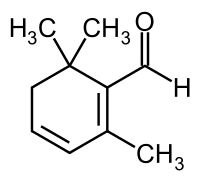Safranal
 | |
| Names | |
|---|---|
| IUPAC names
2,6,6-trimethyl-1,3- cyclohexadiene-1-carboxaldehyde | |
| Identifiers | |
| 116-26-7 | |
| 3D model (Jmol) | Interactive image |
| ChEBI | CHEBI:53169 |
| ChemSpider | 55000 |
| ECHA InfoCard | 100.003.758 |
| PubChem | 61041 |
| UNII | 4393FR07EA |
| |
| |
| Properties | |
| C10H14O | |
| Molar mass | 150.21 g/mol |
| Density | 0.9734 g/cm3 |
| Boiling point | 70 °C (158 °F; 343 K) at 1 mmHg |
| Except where otherwise noted, data are given for materials in their standard state (at 25 °C [77 °F], 100 kPa). | |
| | |
| Infobox references | |
Safranal is an organic compound isolated from saffron, the spice consisting of the stigmas of crocus flowers (Crocus sativus). It is the constituent primarily responsible for the aroma of saffron.
It is believed that safranal is a degradation product of the carotenoid zeaxanthin via the intermediacy of picrocrocin.
Pharmacology
Safranal is an effective anticonvulsant shown to act as an agonist at GABAA receptors.[1][2] Safranal also exhibits high antioxidant and free radical scavenging activity,[3][4] along with cytotoxicity towards cancer cells in vitro.[5] It has also been shown to have antidepressant properties.[6][7]
Natural sources
Natural sources of safranal include:[8]
- Microcystis (cyanobacterium)
- Aspalathus linearis (Rooibos)
- Camellia sinensis (Tea leaf)
- Crocus sativus (Saffron)
- Ficus carica (Fig leaf)
- Lycium chinense (Wolfberry)
- Cuminum cyminum (Cumin Seed)[9]
- Centaurea sibthorpii [10]
- Centaurea amanicola[10]
- Centaurea consanguinea[10]
- Erodium cicutarium (common stork's-bill or pinweed)[10]
- Calycopteris floribunda (Ukshi)[10]
- Sambucus nigra (elderberry)[10]
- Citrus limon (lemon)[10]
- Achillea distans [10]
References
- ↑ Hosseinzadeh H; Talebzadeh F (December 2005). "Anticonvulsant evaluation of safranal and crocin from Crocus sativus in mice". Fitoterapia. 76 (7–8): 722–4. doi:10.1016/j.fitote.2005.07.008. PMID 16253437.
- ↑ Hosseinzadeh H; Sadeghnia HR (April 2007). "Protective effect of safranal on pentylenetetrazol-induced seizures in the rat: involvement of GABAergic and opioids systems". Phytomedicine. 14 (4): 256–62. doi:10.1016/j.phymed.2006.03.007. PMID 16707256.
- ↑ Hosseinzadeh H; Sadeghnia HR (2005). "Safranal, a constituent of Crocus sativus (saffron), attenuated cerebral ischemia induced oxidative damage in rat hippocampus". Journal of Pharmacy & Pharmaceutical Sciences. 8 (3): 394–9. PMID 16401389.
- ↑ Assimopoulou AN; Sinakos Z; Papageorgiou VP (November 2005). "Radical scavenging activity of Crocus sativus L. extract and its bioactive constituents". Phytotherapy Research. 19 (11): 997–1000. doi:10.1002/ptr.1749. PMID 16317646.
- ↑ Escribano J; Alonso GL; Coca-Prados M; Fernandez JA (February 1996). "Crocin, safranal and picrocrocin from saffron (Crocus sativus L.) inhibit the growth of human cancer cells in vitro". Cancer Letters. 100 (1–2): 23–30. doi:10.1016/0304-3835(95)04067-6. PMID 8620447.
- ↑ Hosseinzadeh H; Karimi G; Niapoor M (2004). "Antidepressant effect of Crocus sativus L. stigma extracts and their constituents, crocin and safranal, in mice". Acta Horticulturae. 650: 435–45.
- ↑ Akhondzadeh S; Fallah-Pour H; Afkham K; Jamshidi AH; Khalighi-Cigaroudi F (September 2004). "Comparison of Crocus sativus L. and imipramine in the treatment of mild to moderate depression: A pilot double-blind randomized trial ISRCTN45683816". BMC Complementary and Alternative Medicine. 4: 12. doi:10.1186/1472-6882-4-12. PMC 517724
 . PMID 15341662.
. PMID 15341662. - ↑ "List of Chemicals". sun.ars-grin.gov. Retrieved 2008-03-02.
- ↑ Yan JH; Tang KW; Zhong M; Deng NH (November 2002). "[Determination of chemical components of volatile oil from Cuminum cyminum L. by gas chromatography-mass spectrometry]". Se Pu (in Chinese). 20 (6): 569–72. PMID 12683011.
- 1 2 3 4 5 6 7 8 Ramin Rezaee; Hossein Hosseinzadeh (January 2013). "[Safranal: From an Aromatic Natural Product to a Rewarding Pharmacological Agent]". Iranian Journal of Basic Medical Sciences. 16 (1): 12–26. PMC 3637901
 . PMID 23638289.
. PMID 23638289.
This article is issued from Wikipedia - version of the 6/5/2016. The text is available under the Creative Commons Attribution/Share Alike but additional terms may apply for the media files.